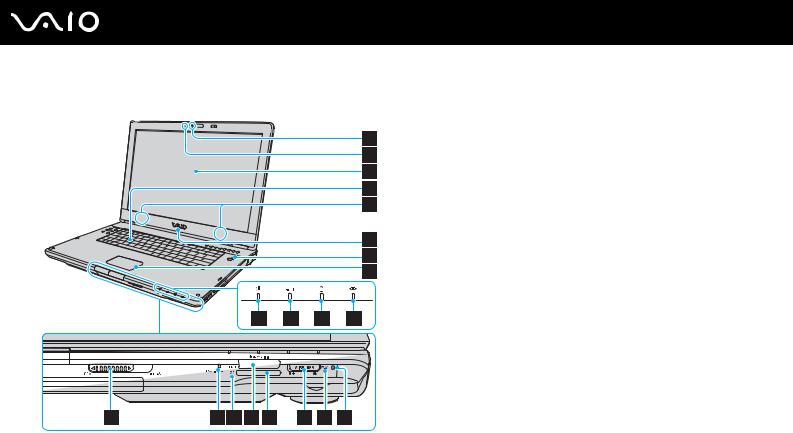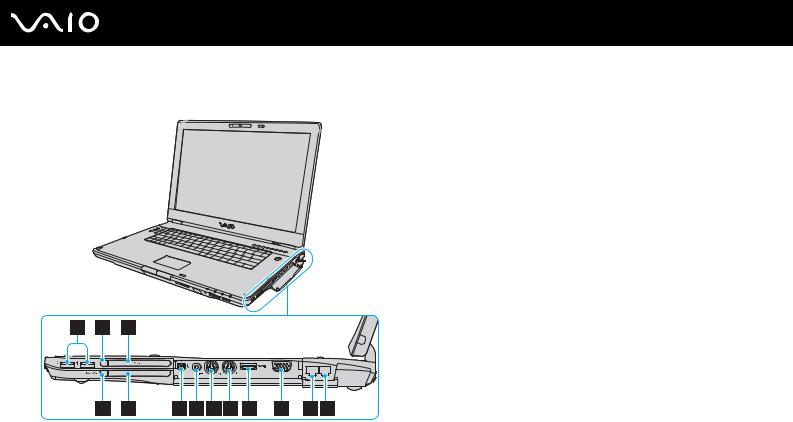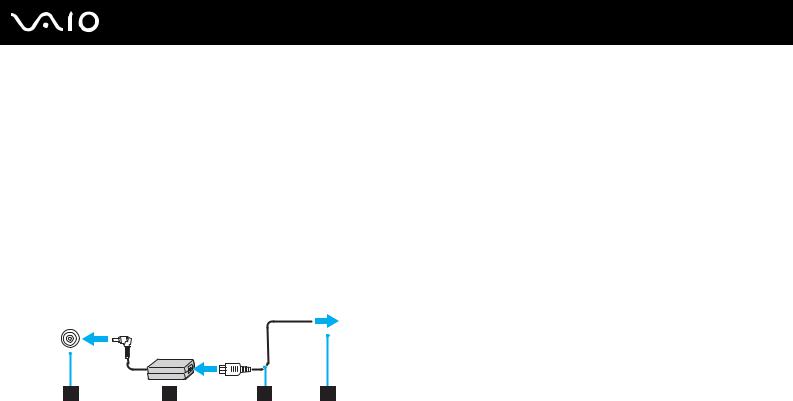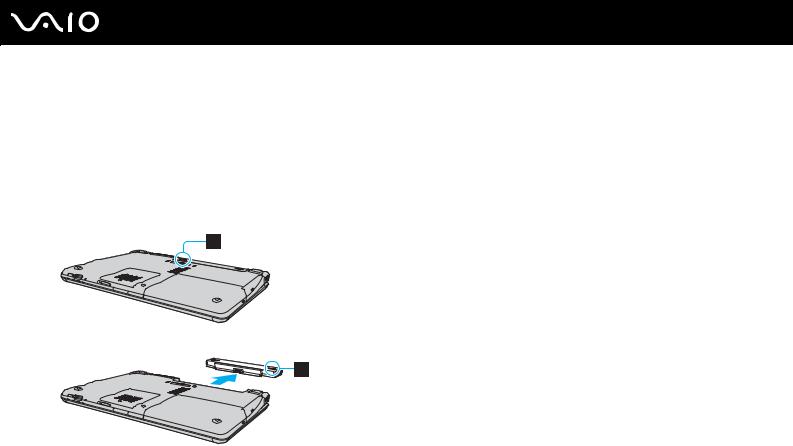Sony VAIO VGN-AR170P, VAIO VGN-AR170GX1, VAIO VGN-AR150G, VAIO VGN-AR190G, VAIO VGN-AR170G User Guide
...
N
User Guide
Personal Computer
V G N - A R 1 0 0 S e r i e s

n 2 N
Contents |
|
Before Use ......................................................................................................................................................................... |
6 |
Documentation............................................................................................................................................................. |
6 |
Ergonomic Considerations........................................................................................................................................... |
9 |
Getting Started ................................................................................................................................................................. |
11 |
Locating Controls and Ports....................................................................................................................................... |
12 |
About the Indicator Lights .......................................................................................................................................... |
19 |
Connecting a Power Source ...................................................................................................................................... |
21 |
Using the Battery Pack .............................................................................................................................................. |
23 |
Shutting Down Your Computer Safely ....................................................................................................................... |
27 |
Using Your VAIO Computer ............................................................................................................................................. |
28 |
Using the Keyboard ................................................................................................................................................... |
29 |
Using the Touch Pad ................................................................................................................................................. |
31 |
Using Special-function Buttons .................................................................................................................................. |
32 |
Using the Built-in MOTION EYE Camera................................................................................................................... |
34 |
Using the Optical Disc Drive ...................................................................................................................................... |
35 |
Using the TV Function ............................................................................................................................................... |
46 |
Using PC Cards ......................................................................................................................................................... |
61 |
Using the ExpressCard Media ................................................................................................................................... |
64 |
Using the Memory Stick Media .................................................................................................................................. |
68 |
Using Other Memory Cards ....................................................................................................................................... |
71 |
Using the Internet....................................................................................................................................................... |
74 |

n 3 N
Using Wireless LAN (WLAN) ..................................................................................................................................... |
75 |
Using the Bluetooth Functionality .............................................................................................................................. |
84 |
Using Peripheral Devices................................................................................................................................................. |
89 |
Connecting a Multi Function Bay Docking Station ..................................................................................................... |
90 |
Connecting External Speakers .................................................................................................................................. |
99 |
Connecting an External Display ............................................................................................................................... |
100 |
Selecting Display Modes.......................................................................................................................................... |
109 |
Using the Multiple Monitors Function....................................................................................................................... |
110 |
Connecting an External Microphone........................................................................................................................ |
112 |
Connecting a Universal Serial Bus (USB) Device.................................................................................................... |
113 |
Connecting a Printer ................................................................................................................................................ |
116 |
Connecting an i.LINK Device ................................................................................................................................... |
117 |
Connecting to a Network (LAN) ............................................................................................................................... |
119 |
Customizing Your VAIO Computer ................................................................................................................................ |
121 |
Setting the Password ............................................................................................................................................... |
122 |
Setting Up Your Computer with VAIO Central ......................................................................................................... |
124 |
Using the Power Saving Modes ............................................................................................................................... |
125 |
Managing Power with VAIO Power Management.................................................................................................... |
130 |
Upgrading Your VAIO Computer.................................................................................................................................... |
132 |
Adding and Removing Memory................................................................................................................................ |
133 |

n 4 N
Precautions .................................................................................................................................................................... |
138 |
On Handling the LCD Screen .................................................................................................................................. |
139 |
On Using the Power Source .................................................................................................................................... |
140 |
On Handling Your Computer.................................................................................................................................... |
141 |
On Using the Built-in MOTION EYE Camera........................................................................................................... |
143 |
On Handling Floppy Disks ....................................................................................................................................... |
143 |
On Handling Discs ................................................................................................................................................... |
144 |
On Using the Battery Pack....................................................................................................................................... |
145 |
On Using Headphones............................................................................................................................................. |
146 |
On Handling Memory Stick Media............................................................................................................................ |
146 |
On Handling the Hard Disk ...................................................................................................................................... |
147 |
Troubleshooting ............................................................................................................................................................. |
148 |
Computer ................................................................................................................................................................. |
150 |
System Security ....................................................................................................................................................... |
158 |
Battery...................................................................................................................................................................... |
160 |
Built-in MOTION EYE Camera................................................................................................................................. |
162 |
Internet..................................................................................................................................................................... |
165 |
Networking ............................................................................................................................................................... |
167 |
Bluetooth Technology .............................................................................................................................................. |
170 |
CDs and DVDs......................................................................................................................................................... |
174 |
Display ..................................................................................................................................................................... |
179 |
Printing..................................................................................................................................................................... |
183 |
Microphone .............................................................................................................................................................. |
184 |
Mouse ...................................................................................................................................................................... |
185 |

n 5 N
Speakers.................................................................................................................................................................. |
186 |
Touch Pad................................................................................................................................................................ |
187 |
Keyboard.................................................................................................................................................................. |
188 |
Floppy Disks ............................................................................................................................................................ |
189 |
PC Cards ................................................................................................................................................................. |
190 |
Audio/Video.............................................................................................................................................................. |
191 |
Memory Stick Media ................................................................................................................................................ |
192 |
Peripherals ............................................................................................................................................................... |
193 |
Multi Function Bay Docking Station ......................................................................................................................... |
194 |
Support Options ............................................................................................................................................................. |
195 |
Sony Support Information ........................................................................................................................................ |
195 |
Program Support Information................................................................................................................................... |
198 |

n 6 N
Before Use
Before Use
Congratulations on your purchase of this Sony VAIO® computer, and welcome to the on-screen User Guide. Sony has combined leading-edge technology in audio, video, computing, and communications to provide state-of-the-art personal computing.
Documentation
Your documentation includes printed information and user guides to read on your VAIO computer.
Printed Documentation
Welcome mat — Contains an overview of connections, setting up information, etc.
Safety information — Contains safety guidelines and owner information.

n 7 N
Before Use
Non-printed Documentation
User Guide (this manual) — Contains features of your computer. It also includes information about the software programs included with your computer, as well as information on solving common problems.
Specifications — The online Specifications describe the hardware and software configuration of your VAIO computer. To view the online Specifications:
1 Connect to the Internet.
2 Go to the Sony online support Web site at http://esupport.sony.com/EN/VAIO/ for customers in USA,
at http://www.sony.ca/support for customers in Canada, or at http://esupport.sony.com/ES/ for customers in Latin American countries or areas.
VAIO Recovery Guide — Provides information about restoring individual software programs, software drivers, and drive partition(s) or your entire hard disk drive to the original factory installed settings.
To access this on-screen guide:
1 Click Start, point to All Programs, and click VAIO Support Central.
2 Click VAIO Documentation.
3 Click VAIO Recovery Guide.
RAID guide (Selected models only) — Provides an overview of RAID systems and the various RAID levels (or types) that can be configured with your VAIO computer. It lists detailed procedures for using the RAID Recovery program to configure the hard disk drives, change your computer's RAID array, or to remove the RAID configuration. Additional procedures are also provided for using the VAIO Recovery utility and the Intel Storage Utility programs.
To access this on-screen guide:
1 Click Start, point to All Programs, and click VAIO Support Central.
2 Click VAIO Documentation.
3 Click RAID guide.

n 8 N
Before Use
MCE guide (Selected models only) — Provides information about using the Windows XP Media Center Edition operating system.
To access this on-screen guide:
1 Click Start, point to All Programs, and click VAIO Support Central.
2 Click VAIO Documentation.
3 Click MCE guide.

n 9 N
Before Use
Ergonomic Considerations
You will be using your computer as a portable device in a variety of environments. Whenever possible, you should attempt to take account of the following ergonomic considerations to both stationary and portable environments:
Position of your computer – Place the computer directly in front of you (1). Keep your forearms horizontal (2), with your wrists in a neutral, comfortable position (3) while using the keyboard, touch pad, or external mouse. Let your upper arms hang naturally at your sides. Have breaks during sessions with your computer. Excessive use of the computer may strain muscles or tendons.
Furniture and posture – Sit in a chair with good back support. Adjust the level of the chair so your feet are flat on the floor. A footrest may make you more comfortable. Sit in a relaxed, upright posture and avoid slouching forward or leaning far backwards.

n 10 N
Before Use
Viewing angle of the computer's display – Use the display's tilting feature to find the best position. You can reduce eye strain and muscle fatigue by adjusting the tilt of the display to the proper position. Adjust the brightness setting of the display as well.
Lighting – Choose a location where windows and lights do not create glare and reflection on the display. Use indirect lighting to avoid bright spots on the display. You can also purchase accessories for your display that help reduce glare. Proper lighting adds to your comfort and work effectiveness.
Positioning an external display – When using an external display, set the display at a comfortable viewing distance. Make sure the display screen is at eye level or slightly lower when you are sitting in front of the monitor.

n 11 N
Getting Started
Getting Started
This section describes how to get started with using your VAIO computer.
!
Before the first computer startup, do not connect any new hardware that did not normally come with your computer. Make sure to start up your computer with only the supplied accessories connected and set up your system. Upon completion, connect one device (for example, a printer, external hard disk drive, scanner, and so on) at a time, following the manufacturer's instructions.
Locating Controls and Ports (page 12)
About the Indicator Lights (page 19)
Connecting a Power Source (page 21)
Using the Battery Pack (page 23)
Shutting Down Your Computer Safely (page 27)

n 12 N
Getting Started
Locating Controls and Ports
Take a moment to identify the controls and ports shown on the following pages.

n 13 N
Getting Started
Front
A Built-in MOTION EYE camera (page 34)
B Built-in MOTION EYE camera indicator (page 19)
C LCD screen (page 139)
D Keyboard (page 29)
E Built-in speakers
F VAIO logo lamp (page 32)
G Power button / Power indicator (page 19)
H Touch pad (page 31)
I Power indicator (page 19)
J Battery indicator (page 19)
K Hard disk drive indicator (page 19)
L Memory Stick PRO/Duo media indicator (page 19)
M LCD screen lid LOCK/RELEASE switch
Make sure to slide this switch to the LOCK position before moving your computer.
N Built-in microphone (monaural)
O SD memory card indicator (page 19)
P Memory Stick PRO/Duo media slot*1 (page 69)
Q SD memory card slot (page 71)
R WIRELESS switch (page 75)
S WLAN (Wireless LAN) indicator (page 19)
T Bluetooth indicator*2 (page 19)
*1 |
Your computer supports Memory Stick PRO media and Memory Stick Duo |
|
media with high speed and high capacity capabilities. |
*2 |
On selected models only. |

n 14 N
Getting Started
A Num lock indicator (page 19)
B Caps lock indicator (page 19)
C Scroll lock indicator (page 19)
D S1/S2 buttons (page 32)
E VOLUME buttons (page 32)
F Disc drive eject button (page 35)
G Muting button (page 32) / Muting indicator (page 19)
H CHANNEL buttons* (page 32)
I TV REC button* (page 32)
J Play/Pause button (page 32)
K Stop button (page 32)
L Previous track button (page 32)
M Next track button (page 32)
N AV MODE button (page 32)
*On selected models only.

n 15 N
Getting Started
Back
A VHF/UHF port*1 (page 46)
B Air vent
C Battery connector (page 23)
D Hi-Speed USB (USB 2.0) port*2 (page 113)
E DC IN port (page 21)
*1 On selected models only.
*2 Supports high-/full-/low- speeds.

n 16 N
Getting Started
Right
A Hi-Speed USB (USB 2.0) ports*1 (page 113)
B PC Card release button (page 63)
C PC Card slot (page 61)
D ExpressCard media release button (page 67)
E Universal ExpressCard slot*2 (page 65)
F i.LINK® (IEEE 1394) S400 port (page 117)
(page 54)
H S VIDEO INPUT port*3 *4 *5 (page 54)
I S VIDEO OUTPUT port*5 *6 (page 105)
J HDMI port (page 105)
K Monitor (VGA) port*6 (page 101)
L Network (Ethernet) port (page 119)
M Modem port (page 74)
*1 |
Supports high-/full-/low- speeds. |
*2 |
Referred to as the ExpressCard slot hereinafter. |
*3 |
On selected models only. |
*4 |
Parallel use of the AV In jack and the S VIDEO INPUT port will direct video |
|
signals to the S VIDEO INPUT port. |
*5 |
Referred to as the S VIDEO IN port and the S VIDEO OUT port hereinafter. |
*6 |
Disabled when your computer is attached to the optional multi function bay |
|
docking station. |

n 17 N
Getting Started
Left
A OPTICAL OUT port (Output frequency 96 kHz/48 kHz/44 kHz/
Variable)
Connect digital equipment such as an AV amplifier.
B Microphone jack (page 112)
C Headphones jack (page 99)
D Optical disc drive (page 35)
E Substitute drive eject button (page 35)/
Optical disc drive indicator (page 19)
F Manual eject hole (page 174)
G Security slot

n 18 N
Getting Started
Bottom
A Multi function bay docking station connector (page 92)
B Air vents

n 19 N
Getting Started
About the Indicator Lights
Your computer is equipped with the following indicator lights.
Indicator |
Functions |
|
|
|
|
Power 1 |
Illuminates when the power of the computer is on, blinks in Standby mode, and turns off when the computer is |
|
|
in Hibernate mode or off. |
|
|
|
|
Battery e |
Illuminates when the computer is using battery power, blinks when the battery is running out of power, and |
|
|
double-blinks when the battery is charging. |
|
|
|
|
Memory Stick PRO/Duo |
Illuminates when data is read from or written to the Memory Stick media. (Do not enter Standby mode or turn |
|
|
off the computer when this indicator is on.) When the indicator is off, the Memory Stick media is not being used. |
|
|
|
|
Muting % |
Illuminates when the volume is turned off. |
|
|
|
|
Built-in MOTION EYE camera |
Illuminates while the built-in MOTION EYE camera is in use. |
|
|
|
|
SD memory card |
Illuminates when data is read from or written to the media in the SD memory card slot. (Do not enter Standby |
|
|
mode or turn off the computer when this indicator is on.) When the indicator is off, the memory card is not being |
|
|
used. |
|
|
|
|
Optical disc drive |
Illuminates when data is read from or written to the optical disc. When the indicator is off, the optical disc is not |
|
|
being used. |
|
|
|
|
Hard disk |
Illuminates when data is read from or written to the hard disk. Do not enter Standby mode or turn off the |
|
computer when this indicator is on. |
||
|
||
|
|
|
Num lock |
Press the Num Lk key to activate the numeric keypad. Press it a second time to deactivate the numeric keypad. |
|
The numeric keypad is not active when the indicator is off. |
||
|
||
|
|
|
Caps lock |
Press the Caps Lock key to type letters in uppercase. Letters appear in lowercase if you press the Shift key |
|
while the indicator is on. Press the key a second time to turn off the indicator. Normal typing resumes when the |
||
|
||
|
Caps lock indicator is off. |
|
|
|

n 20 N
Getting Started
Indicator |
Functions |
Scroll lock
Press the Scr Lk key to change how you scroll the display. Normal scrolling resumes when the Scroll lock indicator is off. The Scr Lk key functions differently depending on the program you are using and does not work with all programs.
Bluetooth technology |
* |
Illuminates when the WIRELESS switch is set to ON and Bluetooth technology is enabled. |
|
||
|
|
|
WIRELESS LAN |
|
Illuminates when the wireless LAN function is running. |
*On selected models only.

n 21 N
Getting Started
Connecting a Power Source
You can use either an AC adapter or a rechargeable battery pack as a power source for your computer.
Using the AC Adapter
Use the computer only with the supplied AC adapter.
To use the AC adapter
1Plug one end of the power cord (1) into the AC adapter (3).
2Plug the other end of the power cord into an AC outlet (2).
3Plug the cable attached to the AC adapter (3) into the DC IN port (4) on the computer or on the optional multi function bay docking station.
!
The shape of the DC In plug varies depending on the AC adapter.

n 22 N
Getting Started
To disconnect the computer completely from AC power, unplug the AC adapter.
Make sure that the AC outlet is easily accessible.
If you do not use the computer for a long period of time, put the computer into Hibernate mode. See Using Hibernate Mode (page 128). This power saving mode saves the time of shutting down or resuming.

n 23 N
Getting Started
Using the Battery Pack
The battery pack supplied with your computer is not fully charged at the time of purchase.
Installing the Battery Pack
To install the battery pack
1Turn off the computer and close the LCD screen lid.
2Slide the battery lock switch (1) to the UNLOCK position.
3 Slide the battery into the battery compartment until it clicks into place.
4 Slide the battery lock switch (1) to the LOCK position to secure the battery on the computer.
When the computer is directly connected to AC power and has a battery pack installed, it uses power from the AC outlet.
!
This computer is designed to operate only with genuine Sony batteries.

n 24 N
Getting Started
Charging the Battery Pack
The battery pack supplied with your computer is not fully charged at the time of purchase.
To charge the battery pack
1Install the battery pack.
2Connect the AC adapter to the computer.
The computer automatically charges the battery (the battery indicator light flashes in a double blink pattern as the battery charges). When the battery is about 85% charged, the battery indicator turns off.
Battery indicator light status |
Meaning |
|
|
On |
The computer is using battery power. |
|
|
Blinks |
The battery is running out of power. |
|
|
Double blinks |
The battery is charging. |
|
|
Off |
The computer is using AC power. |
|
|

n 25 N
Getting Started
When the battery is running out of power, both the battery and power indicator lights blink.
Keep the battery pack in the computer while it is directly connected to AC power. The battery pack continues to charge while you are using the computer.
If the battery level falls below 10%, you should either attach the AC adapter to recharge the battery or shut down the computer and install a fully charged battery.
The battery pack supplied with the computer is a lithium ion battery and can be recharged any time. Charging a partially discharged battery does not affect battery life.
The battery indicator light is on while you use the battery pack as a power source. When the battery life is nearly depleted, both the battery and power indicator lights start flashing.
For some software applications and some peripheral devices, the computer may not enter Hibernate mode even when battery life is low. To avoid loss of data when using battery power, you should save your data frequently and manually activate a power management mode, such as Standby or Hibernate. If the battery wears out when the computer enters Standby mode, you will lose any unsaved data. Going back to the previous work state is impossible. To avoid loss of data, you should save your data frequently.
When the computer is directly connected to AC power and has a battery pack installed, it uses power from the AC outlet.

n 26 N
Getting Started
Removing the Battery Pack
!
You may lose data if you remove the battery pack while the computer is on and not connected to the AC adapter or if you remove the battery while the computer is in Standby mode.
To remove the battery pack
1Turn off the computer and close the LCD screen lid.
2Slide the battery lock switch (1) to the UNLOCK position.
3 Slide and hold the battery release latch (2) and slide the battery away from the computer.

n 27 N
Getting Started
Shutting Down Your Computer Safely
To avoid losing unsaved data, be sure to shut down your computer properly, as described below.
To shut down your computer
1Turn off any peripherals connected to the computer.
2Click Start and then Turn Off Computer. The Turn off computer window appears.
3Click Turn Off.
4Respond to any prompts warning you to save documents or to consider other users and wait for the computer to turn off automatically.
The power indicator light turns off.

n 28 N
Using Your VAIO Computer
Using Your VAIO Computer
This section describes how to get the most out of using your computer.
Using the Keyboard (page 29)
Using the Touch Pad (page 31)
Using Special-function Buttons (page 32)
Using the Built-in MOTION EYE Camera (page 34)
Using the Optical Disc Drive (page 35)
Using the TV Function (page 46)
Using PC Cards (page 61)
Using the ExpressCard Media (page 64)
Using the Memory Stick Media (page 68)
Using Other Memory Cards (page 71)
Using the Internet (page 74)
Using Wireless LAN (WLAN) (page 75)
Using the Bluetooth Functionality (page 84)

n 29 N
Using Your VAIO Computer
Using the Keyboard
Your keyboard is very similar to a desktop computer keyboard, but has additional keys that perform model-specific tasks.
Combinations and Functions with the Fn Key
Some functions are not available until Windows is launched.
Combinations/Feature |
Functions |
|
|
|
|
Fn + 8 (F5/F6): brightness control |
Adjusts the LCD brightness of your computer screen. |
|
|
|
To increase lightness intensity, press Fn+F6 and then M or ,, or keep pressing Fn+F6. |
|
|
To decrease lightness intensity, press Fn+F5 and then m or <, or keep pressing Fn+F5. |
|
|
|
Fn + |
/T (F7): display output |
Toggles among your computer screen, an external display, and simultaneous output to both. |
|
||
|
|
! |
|
|
When the computer is attached to the optional multi function bay docking station, this shortcut key toggles |
|
|
between your computer screen and the external display(s) connected to the docking station. |
|
|
|
Fn + |
(F10): zoom |
Changes the screen resolution to magnify/restore your computer's screen view. |
|
||
|
|
|
|
|
The magnified view is not as clear as the standard view, as it is implemented by applying a lower resolution |
|
|
to the computer screen with a higher resolution. |
|
|
This key combination is disabled during video playback. Make sure to quit such software before pressing |
|
|
the key combination. |
|
|
This key combination may not work with graphic images as it magnifies the screen view by changing the |
|
|
resolution. |
|
|
The location and size of software windows may change when the screen view is magnified or the standard |
|
|
view is restored because pressing this key combination changes the resolution. |
|
|
When your computer's screen view is magnified, switching the view to the external display disables the |
|
|
function and restores the standard view. |
|
|
|

n 30 N
Using Your VAIO Computer
Combinations/Feature |
Functions |
||
|
|
|
|
Fn + |
(F12): Hibernate |
Provides for the lowest level of power consumption. When you execute this command, the |
|
states of the system and the peripheral devices are written to the hard disk and the system |
|||
|
|
||
|
|
power is turned off. To return the system to its original state, use the power button to turn on the |
|
|
|
power. |
|
|
|
For details on power management, see Using the Power Saving Modes (page 125). |
|
|
|
|
|
